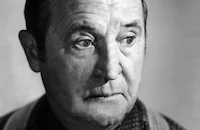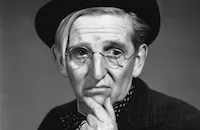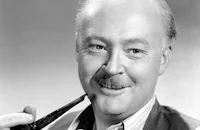The Great Rupert

Brief Synopsis
Cast & Crew
Irving Pichel
Jimmy Durante
Terry Moore
Tom Drake
Frank Orth
Sara Haden
Film Details
Technical Specs

Synopsis
On the day before Christmas, down-on-his-luck entertainer Joe Mahoney rehearses his trained squirrel Rupert in his shabby apartment, but his last hope is shattered when agent Phil Davis informs him that the talented rodent has no box office potential. Dejected and penniless, Joe is evicted by his landlord, Frank Dingle, who lives upstairs with his wife Kate and son Peter. After setting Rupert free in the park, Joe encounters his old friend Louie Amendola, who used to have a human pyramid act with his wife and daughter Rosalinda, but has since fallen on hard times. The Amendolas go to Joe's vacant apartment, and Peter is so taken with Rosalinda that he lets them move in with no money down, to the annoyance of his tight-fisted father. Meanwhile, Rupert, unable to adapt to life in the wild, finds his way back to his old home and settles in the rafters. Dingle receives a notice from the bank telling him that a gold mine he invested in years before has finally paid off, and that he will receive weekly checks for $1,500. Upon cashing the first check, Dingle hides the money behind his bedroom wall, poking it through a hole he has drilled in the baseboard, while Rupert watches from the other side. Downstairs, Mrs. Amendola has just finished praying that their lot in life will be improved when Rupert tosses the money down through the hole in the skylight. Assuming that the money has come from heaven, the Amendolas pay a holiday visit to the Dingles, and Peter and Rosalinda play a duet he has written for the tuba and harp. Phil then shows up with a fruit basket for Joe, and he is immediately attracted to Rosalinda, to Peter's chagrin. Rosalinda agrees to go out with him, hoping he will be able to get Peter's composition published. Meanwhile, after making several extravagant purchases and helping a needy friend, Louie once again finds himself broke. He and Rosalinda urge Mrs. Amendola to pray for more money, and she does so just as Dingle is hiding that week's dividend, and once again Rupert showers them with cash. As the weeks go by, the Amendolas contribute generously to charity and become partners in all of the struggling neighborhood businesses, and Louie secretly lends Peter money to invest in an oil well. One day, a police officer, a tax investigator and an FBI agent show up at the Amendola residence demanding to know where the money is coming from, and Louie invites them to come back Thursday and witness the weekly "miracle." On Thursday, Dingle gets a letter from the bank telling him the gold mine is exhausted and there will be no more checks, while downstairs, Mrs. Amendola repeats her prayer to no avail. As the police, tax and FBI investigators argue over who will interrogate Louie first, Rupert makes off with one of Louie's lit cigarettes, and before long the apartment is filled with smoke. When Peter drags his raving father out of the burning building, everyone realizes where the money came from. The investigators agree to drop the matter, and Louie, whose investments in the local businesses have paid off, offers to help Dingle rebuild his home. A fireman rescues Rupert and sets him free. The squirrel is waiting in the park when Joe returns with a job offer from a circus, and Rupert becomes a great success. Later, while Louie is showing the Dingles through their beautifully refurbished home, Peter receives word that his oil well investment has paid off and he is now rich. Phil drives up and gathers everyone to listen to Peter's song on the car radio, and Peter proposes to Rosalinda, to the great joy of both families.

Director

Irving Pichel
Cast

Jimmy Durante

Terry Moore

Tom Drake

Frank Orth

Sara Haden
Queenie Smith
Chick Chandler

Jimmy Conlin
Rupert [a Squirrel]
Hugh Sanders

Donald T. Beddoe
Candy Candido
Clancy Cooper
Harold Goodwin
Frank Cady
Crew
John Abbot
Ted Allen
Harry Crane
Harry Crane
Jimmy Durante
Ernst Fegté
Harold Godsoe
Duke Goldstone
Flora James
Buddy Kaye
Joseph Kish
Lionel Lindon
William Lynch
James O'hanlon
George Pal
J. S. Pierpont
Miles Pike
Helen Rachmil
Lewis J. Rachmil
Harry Ray
Fred Spielman
Leith Stevens
Curley Twiford
Laslo Vadnay
Clarence Wheeler

Film Details
Technical Specs

Articles
The Great Rupert
Producer: George Pal
Director: Irving Pichel
Screenplay: Laslo Vadnay (screenplay); James O'Hanlon, Harry Crane (additional dialogue); Ted Allen (story)
Cinematography: Lionel Lindon
Music: Leith Stevens
Film Editing: Duke Goldstone
Cast: Jimmy Durante (Mr. Louie Amendola), Terry Moore (Rosalinda Amendola), Tom Drake (Peter 'Pete' Dingle), Frank Orth (Mr. Frank Dingle), Sara Haden (Mrs.Katie Dingle), Queenie Smith (Mrs. Amendola), Chick Chandler (Phil Davis), Jimmy Conlin (Joe Mahoney), Rupert (Himself the Squirrel), Hugh Sanders (Mulligan).
BW-89m.
by Glenn Erickson

The Great Rupert
Quotes
Trivia
The stop motion animation used in creating the illusion of a dancing squirrel (Rupert) was so realistic, director Geroge Pal received many inquiries as to where he got a squirrel that was trained to dance.
Notes
The working titles of this film were Rupert and Rupert II. According to a news item in Daily Variety, the title of Ted Allen's original screen story was "Money, Money, Money." A Hollywood Reporter news item reported that George Baxter had been cast, but his appearance in the final film has not been confirmed. A July 6, 1949 news item in Hollywood Reporter stated that eden ahbez had been signed to collaborate with composer Fred Spielman on the lyrics to "Melody for Two Orphan Instruments," but the song was performed in the film as an instrumental duet for harp and tuba.
"Rupert" was portrayed by both a trained squirrel and a puppet animated through stop-motion photography. The Great Rupert was producer George Pal's first feature film, after many years working on the "Puppetoon" series.














